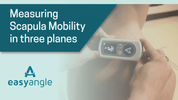-

, by Marko Dombi Athlete-Centric Care: Elevating ACL Rehab with Next-Gen Performance Tools
-

, by Marko Dombi Launch of the EasyBase - Force Plate System For Rehabilitation and Sports
-

, by Marko Dombi Interview with the researcher | Enhanced Paper Grip Test Project
Measuring Scapular Motion in all planes
- , by Jerker Skogby
- 2 min reading time

Measuring scapular motion in all planes had been somewhat limited in the clinical setting until a recent study published by a team of researchers, led by Dr. Tim Uhl, Professor and Director of Musculoskeletal Laboratory at the University of Kentucky. The study focused on the validity of using EasyAngle as an assessment tool for measuring scapular mobility.
Measurements of upward rotation can be taken with an electronic inclinometer, however, reliable measurements in the transverse plane were only possible using bone-pin’s and radiograph/MRI or by 3D motion and video analysis. These systems are expensive and not commonly available in clinics. Dr. Uhl had been looking for a tool to easily measure the shoulder in all three planes in a normal clinical setting. He saw the EasyAngle being demonstrated at the Combined Sections meeting in 2018 and decided to take it back to the lab for some testing.
We were privileged to have the opportunity to visit the University of Kentucky’s Lexington to meet with Nicole Casia, MAT, LAT, ATC, CES and PHD Research Assistant. Nicole kindly demonstrated the protocols for measuring the scapula in all three planes with arm elevation.
In this video, Nicole explains the protocols for taking measurement in all three planes. The device has an inertial measurement unit which allows the user to set zero against gravity in any plane. The measurement is initiated in the plane being measured before being brought to one of the borders of the scapula in the plane being measured. This gives the resting tone of the scapula in that plane. The arm is then extended with the device remaining in close contact with the border of the scapula.
A second reading when the arm is elevated is then either added to or subtracted from the resting measurement depending on which side of the measurement arc the second measurement has landed. The result of that calculation is the degree of movement of the scapula in that plane.
Using EasyAngle for patient motivation
One of the big benefits of using EasyAngle is that you can show the number to the patient. As they progress with treatment, they see the number changing and are motivated to continue with their therapy. Positive improvements in the angle are very encouraging for both patients and parents/guardians.
If you are interested in finding out more, contact the EasyAngle team or join one of our interactive demos where we can show you just how easy it is to use EasyAngle to quantify your work.



